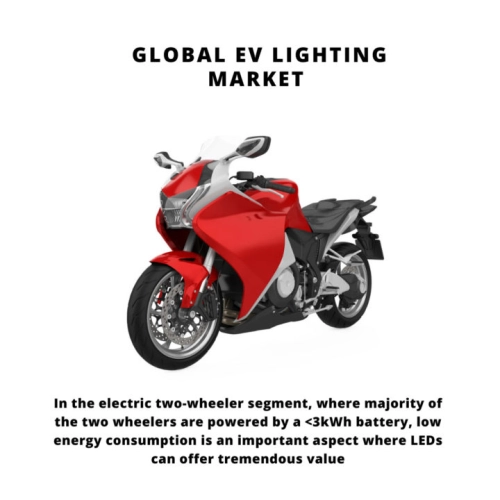
- Get in Touch with Us

Last Updated: Apr 25, 2025 | Study Period: 2023-2030
The automotive industry is going through a historical technological change, and e-mobility is the most important megatrend.

Electric Vehicles (EVs)-BEV (Battery Electric Vehicle) + PHEV (Plug-in-hybrid vehicles) are being touted as futuristic, environment friendly vehicles and one of the key design elements that helps defining that is lighting.

One of the biggest differences in the EV and ICE powered vehicles is that all trims of an EV have LED headlights as standard whereas a similar segment ICE powered vehicle have halogen/HID on lower/mid trims and LED lights are reserved for top of the line variant only.
The reason behind higher fitment of LEDs in EVs is simple, efficiency and durability. A halogen headlight consumes 55W to produce 350-400 Lumens of light, whereas an LED-headlight system uses 16-18W to produce comparable or even higher output. Not to mention, the second most important lighting application- rear and high mount stop lamps, which are by default LEDs
The LED penetration in global automotive lighting has grown to ~11% as of July 2019 as compared to <1% in 2014. EVs have been a major contributor to that and LED penetration in EV lighting is >78%.
The EV lighting market will grow in close co-relation with automotive LED lighting market.
At present, the EV lighting market is a tiny speck in the ~$28-$30 Billion global Automotive lighting market. But going forward, as EV sales increase from ~2 Million units (~2.3% of passenger car sales) in 2018, their contribution will get even bigger by value ($).

The total number of EVs on sale, globally as of July 2019, is 270. China has about 240 alone, followed by US with 45 models and Europe with 30. About 45 models sold are common in at least two of these top 3 markets.
By 2025, the global number of EV models on sale could triple or even go past 1,000.
The EV Lighting Market is estimated at $XXM in 2022, growing to $YYM in 2030.
Among the best-selling EVs in China, in the A00 compact segment, which accounted for 35% of EV sales in 2018(Ex- Chery EQ, JAC iEV6, BYD E6), the low cost BEVs have halogen projectors and not LED due to cost constraints.
But, the EV startups like BYTON, NIO and WEY are offering all -LED lights on their SUVs.
In the mass-segment PHEVs, Mitsubishi Outlander PHEV, one of the best-sellers PHEV models globally has all LED lighting only on the top most variant.
In the electric two-wheeler segment, where majority of the two wheelers are powered by a <3kWh battery, low energy consumption is an important aspect where LEDs can offer tremendous value
Tesla had 19% global market share of battery electric vehicles sold in 2018 and 19% share of all EVs(BEV+PHEV) sold, globally in H1-2019.It has been an early adopter of LED lighting. All Tesla vehicles have LED lighting (Frontal, rear, interior, signaling) as standard since first launch.
Among the European OEMs, BMW which had 7% global EV market share in 2018 is offering all LED lighting on almost all EVs. Majority are PHEVs though

Frontal lighting is the biggest contributor to an automotive lighting supplier`s revenue. It is also the most specialized component which requires deep technical knowledge and rigorous testing. Therefore, many lighting companies in China are still dependent on foreign companies for technology and so far, have only been able to establish themselves only in the domestic and Asian after-market.
Koito is among the leading players in LED and EV lighting market. Owing to its close ties with Toyota(World`s #1 seller of electrified vehicles), it had a head start in 2007 when it launched LED headlights on a Lexus vehicle. And, now it is reaping benefits from that expertise
Eyeing the growing EV market in China, Hella (among the market leaders in automotive lighting) has already expanded its production capacity in 2017.
India based Varroc Lighting Systems is a supplier to Tesla for Model S and X, supplying complete lighting system.
Coming down the value chain, Taiwan and South Korea still remain the hub for semi-conductor /chip, PCB manufacturing.
| 1 | Market Segmentation | 3 |
| 2 | Executive Summary | 5-6 |
| 3 | Introduction | 7-15 |
| 4 | Global Automotive lighting technology trends | 16-18 |
| 5 | About EV market and lighting used | 19-20 |
| 6 | Cost breakdown of EV lighting by weight and components | 21-22 |
| 7 | Global EV headlight sourcing trends | 23-24 |
| 8 | Upcoming Electric vehicle platforms and their lighting | 25-27 |
| 9 | Market Size, Dynamics and Forecast, By Lighting technology | 28-35 |
| 10 | Market Size, Dynamics and Forecast, By Lighting position | 36-52 |
| 11 | Market Size, Dynamics and Forecast, By Vehicle type | 53-61 |
| 12 | Market Size, Dynamics and Forecast, By Geography | 62-78 |
| 13 | Value chain of EV lighting | 79-80 |
| 14 | Competitive Landscape | 81-83 |
| 15 | Company Profiles | 84-95 |
| 16 | Details on LED lighting chip suppliers | 96-97 |
| 17 | Unmet needs and Market Opportunity for suppliers | 98 |
| 18 | Conclusion | 99 |
| 19 | 5 Key Predictions for next 5 years | 100-101 |
| 20 | Appendix | 102-104 |